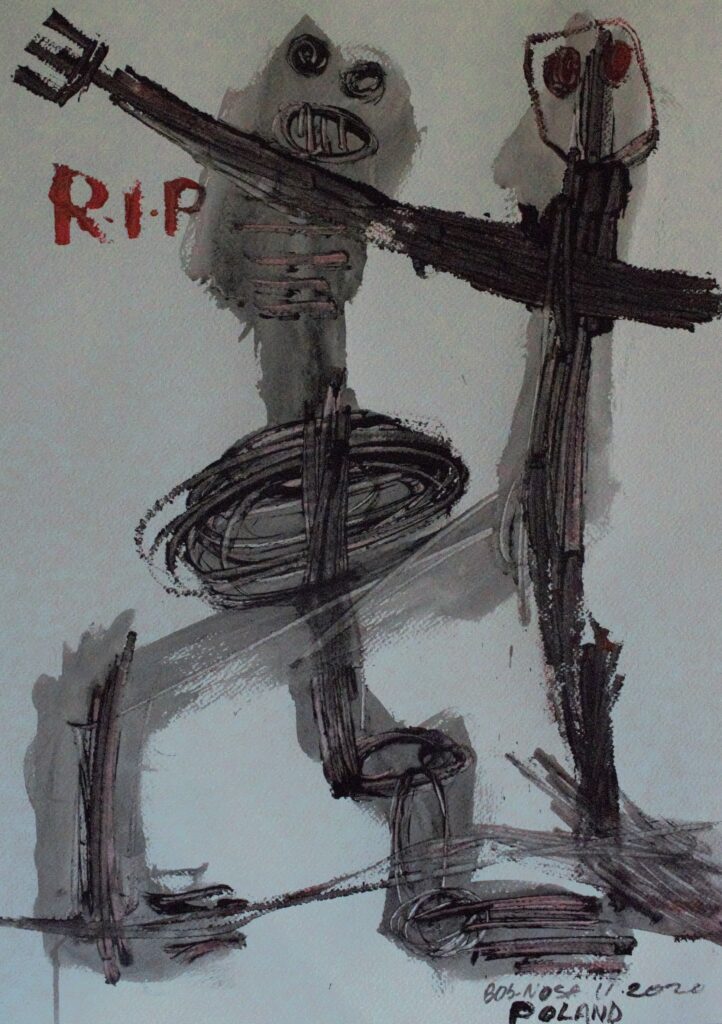I see extraordinary strength in Bob-Nosa’s art — Malgorzata Paszylka-Glaza, curator


By Osa Amadi
Malgorzata Paszylka-Glaza who is also the curator of the Modern Art Department, the National Museum in Gdansk, Poland, had online conversations with VANGUARD NEWSPAPER on diverse issues relating to art, the artist, the exhibition, and a little measure of polish politics.
Poland shares a boundary with East Germany and Communist Russia – two countries that had fought the war (cold and hot wars) with the rest of the world, and you are the curator of the Modern Art Department, The National Museum in Gdansk, Poland. How much of these wars’ artifacts do you have in your museum and what specific messages do they have for Polish people and humanity generally?
Poland, until 1989, was under the influence of the Socialist Union of Soviet Republics. before 1989, Poland was not a free and democratic state. In the period between 1945 (the end of World War II) and 1989, there were workers protests (bloodily suppressed by the authorities), the Solidarity movement, and martial law. Those were difficult times, which were also reflected in our art.
The collections of the National Museum in Gdańsk (the Department of Modern Art is one of the museum’s six branches) includes paintings, sculptures, and graphics that speak the artistic language of these difficult times. They are works of art dedicated to the desire for freedom, equality, democracy, and choice. This universal message is important not only for Poles and Europeans but also for the whole world.
READ ALSO: Nasarawa Attack: 14 missing, 5 killed as police vows to fish out killers
How did you meet Bob Nosa, and what attracted you to his works?
For the first time, the paintings of Bob-Nosa Uwagboe were shown to me by our mutual friend from Berlin – Marek Brodecki. Although Brodecki showed me many other paintings amongst Bob-Nosa’s, only the paintings by Bob-Nosa interested me. I saw in them extraordinary strength, uncompromisingness, and extraordinary artistic maturity. Bob-Nosa’s pictures screamed the truth.
Having had a taste of Nigerian art, and probably coming to the knowledge that there are many other good artists like Bob Nosa in Nigeria, do you plan to feature more Nigerian artists in exhibitions here in Poland?
I am just getting to know the artistic environment of Nigeria, but so far, I have not met artists with such a power of creation as Bob-Nosa. I am thinking of a large exhibition presenting selected aspects of contemporary African art. Perhaps it will be an opportunity to show the art of other Nigerian Artists. Perhaps.
What is the level of acceptance for Bob’s works here among the people?
Art in Europe has a long avant-garde tradition. The works of Bob-Nosa arouse extraordinary interest in the audience, amaze with courage, and, above all, remain in the memory for a long time.
Did you make good sales and good money from the exhibition?
The exhibition, “Transit” by Bob-Nosa Uwagboe” is presented at the National Museum in Gdańsk, and museums (especially national ones) in Europe and in the world cannot and do not sell works presented at exhibitions organized there. I personally did not earn anything from it, because as a museum staff I cannot trade in art. The monographic exhibition at the National Museum is a great honor for the Artist. Not every artist grows up for an exhibition in a museum, because the museum space is specific. This space requires maturity and outstanding talent.
Bob Nosa has been with you in Poland now for more than 4 months. Without trying to be nice to him, tell us your impression of him, both as an artist and as an ordinary person.
Bob-Nosa is an outstanding and extremely talented Artist to whom the future belongs. But he is also a wise, good and loyal person. I admire his strength and wisdom in life. I really like talking to him about art, life, and Africa. Bob-Nosa loves Africa and teaches me to understand this continent. COVID-19 has changed a lot in people’s lives. Life will never be the same again, but it has given us an extraordinary and wise friend for life.
What social, political, economic, or environmental challenges are facing the Polish people now, or have your people solved all your problems?
READ ALSO: Saudi Arabia concludes downsized hajj amid pandemic
Poland is a country of young democracy (since 1989). We are still learning many things. We are a member of the European Union. Our economy is relatively stable and unemployment is relatively low. For several years, the power in Poland has been exercised by the right-wing, which is cautious to the European Union and emigrants.
In Poland, 80 percent are Catholics, and the Catholic Church too often gets mixed up in politics. Sometimes we also have a problem with tolerance because we are a very homogeneous society. The current government in Poland has led to a large division of society into its staunch supporters and equally staunch opponents, and this is not good. In exercising power, common sense and the good of all citizens are important, and not only those who support power.
We hear that Polish women like African men. Did some of the women try to steal Nosa’s heart away and make him stay permanently in Poland?
It is stereotypical thinking that white women, including Poles, love Africans. Love does not depend on skin color and place of origin. In Poland, Bob-Nosa is, first and foremost, a very interesting Artist and only then, a man. Bob-Nosa has a group of his admirers, but I think they admire his talent and artistic courage. Moreover, Bob-Nosa has a family in Lagos, Nigeria – a beautiful and wise wife and a wonderful son. And that’s the highest value.
The post I see extraordinary strength in Bob-Nosa’s art — Malgorzata Paszylka-Glaza, curator appeared first on Vanguard News.
No comments: